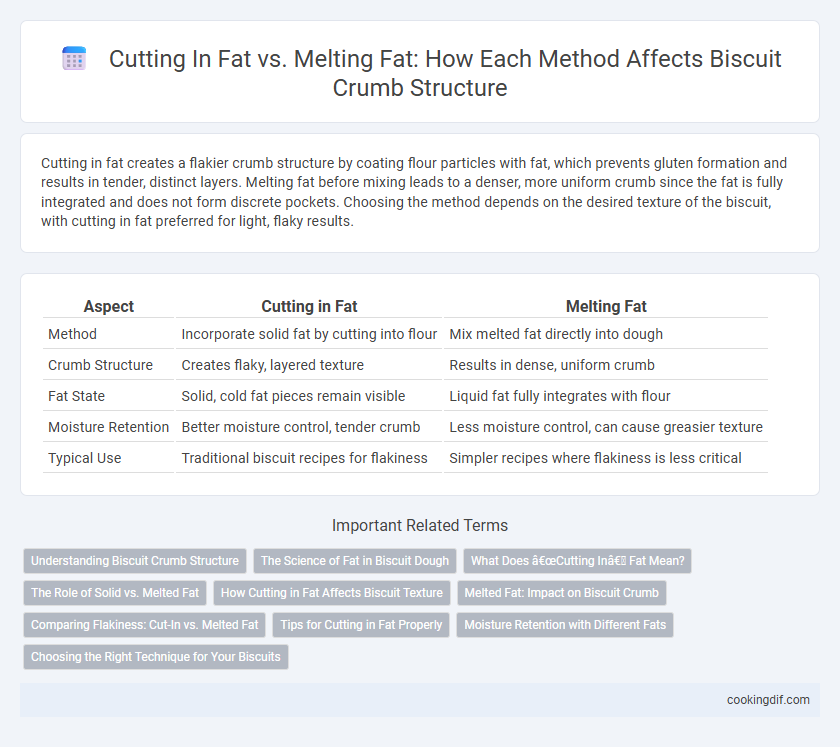Cutting in fat creates a flakier crumb structure by coating flour particles with fat, which prevents gluten formation and results in tender, distinct layers. Melting fat before mixing leads to a denser, more uniform crumb since the fat is fully integrated and does not form discrete pockets. Choosing the method depends on the desired texture of the biscuit, with cutting in fat preferred for light, flaky results.
Table of Comparison
| Aspect | Cutting in Fat | Melting Fat |
|---|---|---|
| Method | Incorporate solid fat by cutting into flour | Mix melted fat directly into dough |
| Crumb Structure | Creates flaky, layered texture | Results in dense, uniform crumb |
| Fat State | Solid, cold fat pieces remain visible | Liquid fat fully integrates with flour |
| Moisture Retention | Better moisture control, tender crumb | Less moisture control, can cause greasier texture |
| Typical Use | Traditional biscuit recipes for flakiness | Simpler recipes where flakiness is less critical |
Understanding Biscuit Crumb Structure
Cutting in fat creates discrete fat pockets that, when baked, melt and release steam, forming flaky layers essential for a tender biscuit crumb structure. Melting fat before mixing disperses fat evenly, resulting in a denser, cake-like crumb due to the lack of steam pockets separating the flour layers. Recognizing how fat incorporation affects the crumb is crucial for achieving desired biscuit texture and flakiness.
The Science of Fat in Biscuit Dough
Cutting fat into biscuit dough creates small, solid fat pockets that melt during baking, producing flaky layers and a tender crumb structure. Melting fat before incorporating leads to a more uniform distribution, resulting in a softer, denser biscuit texture. Understanding the role of solid versus melted fat is crucial for controlling biscuit crumb and tenderness through fat's impact on gluten development and steam generation.
What Does “Cutting In” Fat Mean?
Cutting in fat refers to the process of incorporating solid fats like butter or shortening into dry ingredients until the mixture resembles coarse crumbs, which creates distinct layers in biscuits and contributes to a flaky crumb structure. This technique contrasts with melting fat, which blends fully into the dough and results in a denser, less flaky texture. Properly cutting in fat traps air and moisture, essential for achieving the tender, airy crumb characteristic of high-quality biscuits.
The Role of Solid vs. Melted Fat
Solid fat, such as cold butter or shortening, creates distinct layers within biscuit dough by cutting into flour, which traps air and results in a flaky, tender crumb structure. Melted fat incorporates fully into the dough, leading to a denser, more uniform texture with less rise. The choice between solid and melted fat directly influences the biscuit's crumb, with solid fat providing lift and flakiness while melted fat produces softness and moisture.
How Cutting in Fat Affects Biscuit Texture
Cutting in fat creates small, coated fat particles that inhibit gluten formation, resulting in a tender and flaky biscuit crumb structure. The distribution of solid fat pockets melts during baking, producing steam that lifts the dough and forms layers. This technique contrasts with melting fat beforehand, which leads to a denser, less layered biscuit texture.
Melted Fat: Impact on Biscuit Crumb
Melted fat in biscuit dough penetrates flour particles more thoroughly, resulting in a tender and cohesive crumb structure with enhanced moisture retention. Unlike solid fat cut into small pieces, melted fat creates a uniform fat distribution that minimizes large air pockets and promotes even gluten inhibition. This method yields biscuits with a soft, delicate crumb and a more consistent, fine texture.
Comparing Flakiness: Cut-In vs. Melted Fat
Cutting in fat creates distinct layers by coating flour particles with solid fat, resulting in a flakier biscuit crumb structure; melted fat blends more thoroughly into the dough, producing a denser, less flaky texture. The cold, solid fat chunks in cut-in methods form steam pockets during baking, which contribute to the characteristic flaky layers. In contrast, melted fat integrates fully, reducing steam formation and leading to a more uniform, tender crumb without the pronounced flakiness.
Tips for Cutting in Fat Properly
Cutting in fat properly ensures a tender, flaky biscuit crumb by evenly distributing small fat particles throughout the dough, which creates steam pockets during baking. Use cold fat like butter or shortening and a pastry cutter or two knives to cut it into pea-sized pieces without overworking the dough, preserving the fat's structural integrity. Chilling the dough briefly before baking helps maintain visible fat layers for an optimal crumb texture.
Moisture Retention with Different Fats
Cutting in solid fats like butter or shortening creates small fat pockets that inhibit gluten formation, resulting in a tender, flaky biscuit crumb with improved moisture retention. Melting fats before mixing bind more uniformly with flour, producing a denser crumb that retains moisture differently, often yielding a softer but less layered texture. The choice between cutting in and melting fats directly influences the biscuit's crumb structure and overall moisture levels, affecting shelf life and mouthfeel.
Choosing the Right Technique for Your Biscuits
Cutting in fat creates small, solid pieces of butter or shortening that release steam during baking, resulting in a flaky and tender crumb structure. Melting fat, on the other hand, produces a denser biscuit with a finer crumb since the fat is evenly dispersed throughout the dough. Choosing the right technique depends on whether you desire a light, layered texture (cut-in fat) or a softer, more uniform crumb (melted fat) for your biscuits.
Cutting in fat vs melting fat for crumb structure Infographic

 cookingdif.com
cookingdif.com